"The Place is Here, The Time is Now"
DOE's Director of Basic Energy Sciences Announces Award of CD-1 to NSLS-II Project
July 31, 2007
More than 450 participants in a major users workshop for the National Synchrotron Light Source II (NSLS-II) were among the first to hear the news that the planned successor to Brookhaven's existing Light Source will be located here.
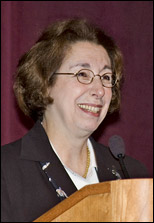
Patricia Dehmer
Pat Dehmer, Director of the Department of Energy's (DOE) Office of Basic Energy Sciences (BES), made the dramatic announcement that the project had been awarded "Critical Decision One" (CD-1) in the five-step DOE approval process at the opening plenary session for the two-day workshop and it was greeted with sustained applause by the overflow audience in Berkner Hall.
Before announcing the project milestone, Dehmer detailed the hard work that went into bringing it about after DOE approved the Mission Need with the designation of CD-0 in August of 2005. Following the project's exhaustive but successful Lehman Review at the end of last year, it was then examined by Deputy U.S. Energy Secretary Clay Sell's largely non-technical advisory board, which must approve every project of this magnitude. After all the panel's difficult questions had been answered, Sell approved NSLS-II's CD-1 status.
"I tend to fall in love with my construction projects," she said. "I have already fallen in love with this one."
But while congratulating BNL on their achievement, she cautioned that there is much hard work ahead, and nothing can be taken for granted.
"In my opinion, CD-1 is the most critical of the critical decisions in the life of a young project," Dehmer said. "But many projects have been stopped at that point. The scientific community must be engaged today."
Urging the audience's "early and substantive involvement, " she said: "There are opportunities that come to only a very few people in the right place at the right time. The place is here, the time is now."
Before Dehmer's announcement, Presidential Science Advisor and former BNL Director John Marburger congratulated the designers of the proposed NSLS-II for the "cleverness that has gone into the design, and the thought given to safety. NSLS-II is full of tricks to enhance photon strength and brightness," he said, adding that as planned, the NSLS-II is "such an impressive machine that I predict it will be built."
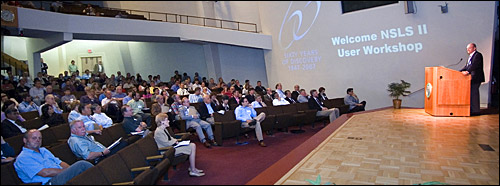
John Marburger addresses the attendees of the NSLS-II User Workshop
Marburger spoke of some of the challenges the project will face in light of the many competing priorities for science funding, noting that historically, big funding for science has gone to the space program and big machines like RHIC, but that "instrumentation and computing sustain all else."
"Facilities like NSLS-II are essential for solving the vexing problems of society," he said. "We need to find a way to ensure U.S. researchers continued development and access to facilities enabling atomic engagement with matter," he said.
Workshop Solicits Input
Steve Dierker, Associate Laboratory Director (ALD) for Light Sources and Project Director for NSLS-II, welcomed the overflow crowd of prospective users of the new BNL facility and asked for their assistance.
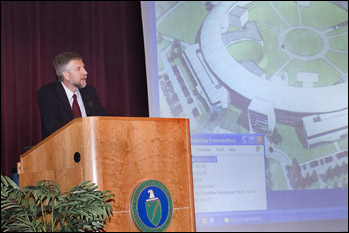
Steve Dierker
"At this meeting, you will have a chance to help chart the future course of this facility," he said. "You input is crucial to our success."
Dierker gave an overview of the project, which he predicted will restore U.S. standing in synchrotron science, offering unprecedented spatial and energy resolution. Examples of research that NSLS-II will uniquely enable include structure and properties such as new electronic materials that scale beyond silicon and designer catalysts; self assembly, such as interactions between nanoscale building blocks and the kinetics of nanoscale assembly, and emergent behavior, such as the dynamics of charge and spin stripes in high temperature supercomputers.
"We now know that it is largely at the nanoscale where materials properties and functions are determined," he said. "Today, we need probes of materials much more powerful than current synchrotrons. We need to directly image at the nanoscale."
The project scope currently calls for accelerator systems including a 1/2 mile-circumference storage ring, conventional facilities including an operations center and laboratory/office buildings, and experimental facilities capable of hosting at least 58 beamlines. Dierker also outlined plans for the Joint Photon Sciences Institute (JPSI), envisioned as an intellectual center for development and application of photon sciences and a gateway for users of NSLS-II. The building will offer laboratories, meeting areas and office space and will be paid for by New York State, which has committed $30 million for its construction.
Dierker described his management team that leads the project, including Jim Yeck, Deputy Project Director for Project Management, Satoshi Ozaki, Associate Director for the Accelerator Systems Division, John Hill, Associate Director for the Experimental Facilities Division, Marty Fallier, Associate Director for the Conventional Facilities Division, and Diane Hatton, Associate Director for the Project Support Division. Advisory committees for each of the three technical divisions meet twice a year to provide input and guidance to the project. A Project Advisory Committee, which also meets twice a year, is charged with reviewing the project as a whole on a variety of matters. Beamline Advisory Teams, or BATs, will help define the scientific mission and technical requirement for the beamlines, including design features and instrumentation concepts.
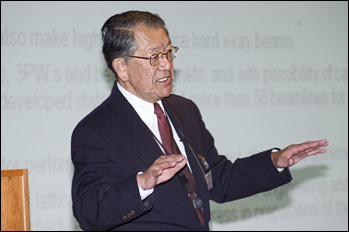
Satoshi Ozaki
Satoshi Ozaki described the latest design for the massive machine. In order to reach its world-leading technical goals NSLS-II needs to produce ultra-bright and stable synchrotron radiation, Ozaki said. Ozaki highlighted the specifics of the NSLS-II accelerator system, which spans from the generation of the electron beam at an energy of 200 million electron-volts (MeV) to the beam's transfer to the storage ring, where the electrons are stored at an energy of 3 gigaelectron volts (GeV) and sent through insertion devices and bend magnets to produce synchrotron radiation.
One of the main concerns in designing the NSLS-II magnet arrangement, or lattice, is ensuring that it produces low emittance, a beam characteristic where the electrons are confined to a small distance and have nearly the same momentum. At NSLS-II, Ozaki said, this will be achieved with devices called damping wigglers, which cause the electrons to oscillate transversely and emit radiation. The energy lost to the synchrotron radiation is then restored to the beam in the forward direction by radio-frequency accelerating sections, which reduces the transverse spread of the particles. The use of damping wigglers for emittance control is a novel approach for a light source, but a well-established technology for high-energy physics accelerators and colliders, Ozaki said.
Further optimization of the lattice and beam stability, as well as engineering and design, cost estimating, and schedule planning are in progress for preparation of the CD-2 review in November, said Ozaki, whose recently announced replacement as Associate Director for the Accelerator Systems Division is Ferdinand Willeke.
Planned Facilities Described
Marty Fallier described his vision for a "great environment to carry out research," from the main entry lobby, which will serve as a venue for events and a gathering place for tours and other activities, to a loading area with rolling access to all beamlines, and Lab office buildings and service buildings that will be located along the inside and outside of the storage ring.
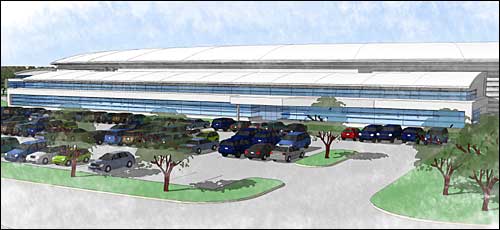
Design for a typical NSLS-II Laboratory Office Building (LOB).
The project team expects that NSLS-II will achieve the Gold Standard for Leadership in Energy and Environmental Design (LEED) awarded by the United States Green Building Council. LEED is the nationally accepted benchmark for the design, construction, and operation of high-performance green buildings, offering tool for sustainable site development, water savings, energy efficiency, materials selection and indoor environmental quality.
Issues key to the construction of NSLS-II are building stability, and vibration and temperature control. "Vibration is the biggest challenge for the ring," Fallier said. "Stability is dependent on the conventional facilities."
Fallier said that although the design of the new facility is well underway, additional studies are being conducted on vibrational and thermal stability, with another technical review scheduled in September.
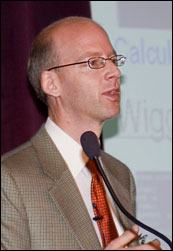
John Hill
The conventional facilities will also offer a layout enabling longer beamlines and future expansion for full beamline build-out. Fallier also promised a "reasonably quiet" experimental floor and convenient parking and access to labs, offices and beamlines. He said a covered walkway and possibly heated sidewalks may connect the NSLS-II with the Center for Functional Nanomaterials (CFN).
In discussing plans for the experimental facilities, "the embodiment of the scientific vision" for NSLS-II, John Hill described the conceptual design of an accelerator that "has matured into an exciting design, promising superlative experimental capabilities." He detailed the range of radiation sources that will be available to match various scientific needs and many novel features of the design, which includes damping wigglers for hard x-rays, soft-bends for soft x-rays, and three-pole wigglers, also for hard x-rays, and "truly tiny" electron beams. The experimental floor will enable some long beamlines to have hutches outside the experimental hall.
The project aims to provide a minimum suite of insertion device beamlines to meet physical science needs that both exploit the unique capabilities of the NSLS-II source and provide workhorse instruments for large user capacity.
Advanced Science for an World-Leading Light Source
In the first afternoon session, Harvard University Professor of Chemistry Charles Lieber recommended taking a "bottom-up" approach to future exploration of nanoscience, research he said is underutilized but could greatly benefit from the capabilities at NSLS-II. Just like biologists, who study how single pieces of DNA and protein group together to form cells, which, in turn, form an organism, Lieber insisted that nanoscientists also should think about their work as building blocks of increasing complexity - beginning with nanowires and nanoclusters, which make up devices and circuits, and together, can form various cutting-edge electronics, photonics, and biological technologies.
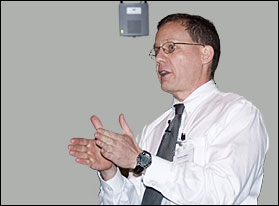
Charles Lieber
But in order to fully understand the properties of these building blocks, and the devices they can form, scientists must "diverge from what's being practiced in industry today and really create new technologies of the future," Lieber said.
Using nanowires as an example, Lieber discussed different methods for characterizing nanomaterials and assembling them into integrated systems. Mastering these techniques could lead to advanced applications such as quantum computing, nano-sized solar cells and power sources, and even an "artificial brain" that can read the input and output of electrical signals, Lieber said.
"These advances require the detailed characterization of structural and electronic properties on multiple-length scales and environments," he said. "And light sources will help drive this science and technology revolution."
Harvard University Medical School Professor Steve Harrison then discussed the future of biomolecular research, stressing that "the characteristics of NSLS-II will allow research in biomolecular structure to go to new kinds of questions and to fulfill those currently created."
The next step in the field, Harrison said, is making "molecular movies" that link live cell dynamics and molecular structure. Advances in x-ray crystallography, a thoroughly practiced technique at the current NSLS, will help researchers achieve that goal, he said. Progress will depend on being able to get good data from very small and weakly diffracting crystals and overcoming technical instrumentation problems.
Researchers will need a very small, stable beam, along with precise sample-handling instruments, and large detectors with very small pixel sizes, Harrison said, adding, "NSLS-II appears to be a great place to do this."
Weighing the Options for User Access
Patrick Gallagher, Director of the NIST Center for Neutron Research, discussed the pros and cons of common user access modes that might be considered for NSLS-II.
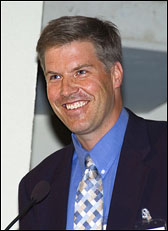
Patrick Gallagher
Emphasizing that there is no perfect model, Gallagher first outlined the Participating Research Team (PRT) model, of which the NSLS is the "poster child." In this model, a team manages and funds beamline development and operation in exchange for up to 75 percent of dedicated beam time access for its team members. The PRT model is successful in cost sharing, and encouraging innovative beamline design and scientific participation, Gallagher said, however, it also can lead to very localized access, poor optimization of beamline development, and inadequate or inconsistent levels of operational funding.
Gallagher then highlighted the more recent General User Partner User (GU/PU) model, which is used by an increasing number of facilities, including the Advanced Photon Source at ANL, the Spallation Neutron Source at ORNL, and others. In the GU/PU model, partnership teams can make contributions to facility-operated beamlines in exchange for up to 20 percent of dedicated beam time access for its members. Gallagher pointed out that while this model allows for a strong facility role in developing and operating beamlines, better optimization, enhanced levels of operational support, and a growing use of traditional proposal-based access, it could lead to less involvement from outside agencies and organizations, less industrial participation, and fewer design innovations.
Although PRT and GU/PU models are the two most prominent user access models at the moment, Gallagher encouraged NSLS-II leaders to weigh their options and invent a system that would work best for their facility.
"We know some end points that are disastrous, but in the middle, there's a lot of room to explore," he said.
John Hill gave a second presentation on beamline development and user access, which will be through peer-reviewed proposals. Hill detailed how the NSLS-II beamlines will be developed with the user community though the BATS and Partner Users. Partner Users will be able to negotiate beamtime to allocate to their members and can also apply for General User time on any beamline. He reiterated the project team's desire to hear from prospective users what capabilities they would like to see in the new facility.
Technique and Science-Based Breakout Sessions
On the workshop's second day, breakout sessions were held on techniques including hard x-ray nanoprobes, soft coherent scattering and imaging, powder diffraction, macromolecular crystallography, liquid interfaces, inelastic x-ray scattering and photoemission spectroscopy. Science based-sessions were held in the areas of life sciences, catalysis, environmental science, high-pressure, strongly correlated electrons, magnetism, soft condensed matter, and radiometry and metrology. Summaries of a few of those sessions are below.
The Radiometry and Metrology session was organized by Jeff Keister (SFA, Inc.) and Peter Takacs (BNL). The objective of the session was to identify a community of national programs and users with specific needs for synchrotron radiation for radiometric and metrological characterization of UV and x-ray detectors and optical components. Speakers included Steve Vernon (LLNL), Tom Tierney (LANL), John Seely (NRL), Rob Vest (NIST), Valeriy Yashchuk (LBNL) and Lahsen Assoufid (ANL).
The twenty-five attendees discussed the scientific importance of having beamlines at NSLS-II and the necessary technical requirements. Such a facility for calibration of optical components is critical to the success of several identified national and international scientific programs, including national security, astronomy, solar physics, high energy density and plasma physics, EUV lithography, high-performance synchrotron instrumentation, and x-ray optical properties of materials. Wide energy range (5 eV - 200 keV, with most of the work below 20 keV), high spectral-purity (>99% power in-band), and large fractions of beam time are expected to be needed to meet the scientific demand for calibrated UV and x-ray components.
The Liquid Interface X-ray Scattering community organized their NSLS-II breakout session around current and future science directions, ranging from the physics of liquid metals to biological membranes. Invited speaker Peter Pershan of Harvard University presented a history of interface scattering, and pointed towards possible new directions in polymers and thin films.
Mathias Loesche of Carnegie-Mellon University discussed membrane systems, stressing the importance of medical relevance for such research and comparing the strengths of x-ray versus neutron techniques. Kent Blasie of the University of Pennsylvania presented interferometric and other methods to extend the basic technique of x-ray reflectivity. Organizers Elaine DiMasi (BNL), Mark Schlossman (University of Chicago), and Masa Fukuto (BNL), along with Ben Ocko (BNL) led discussions on technical topics: new detectors and simultaneous techniques such as optical microscopy and surface spectroscopy. Ocko and Schlossman also presented important considerations for using high energy x-rays to study buried interfaces. Microfocussing and resonant methods were also extensively discussed. More extreme x-ray energy ranges, above 50 keV and below 6 keV, were identified as important new frontiers and will govern the design of upcoming NSLS-I and -II beamlines dedicated to scattering from liquid interfaces. The new directions are expected to benefit other surface science communities also.
A breakout session on Catalysis was organized by Anatoly Frenkel (Yeshiva University), it was focused on brainstorming the following key issues: The future directions of catalysis science at the synchrotrons, What advanced capabilities are needed for the cutting-edge research in catalysis science, The upgrades of "conventional" experiments and techniques, and, finally, What will be the technical, logistical, and financial challenges. The tone for active discussions by many of the 54 workshop participants was set from the very beginning by Ralph Nuzzo (UIUC) in his talk "Understanding Catalysis." Other speakers included A. Frenkel (YU), J. Hanson (BNL) and D. Mullins (ORNL).
Participants identified key scientific drivers in catalysis field: atomistic understanding of activity, selectivity and performance of nanocatalysts for rational design of low-cost and highly active catalysts. Due to intrinsic complexity of spatial and temporal metrics in catalysis research (length scale spanning Anstroms to microns, time scale spanning femtoseconds to minutes), competing effects of cluster-support/adsorbate interactions as well as structural relaxations, heterogeneity, polydispersity etc. of nanocatalysts, the world-best leading spatial resolution and flux that will be available at the NSLS-II are needed to advance synchrotron catalysis research. Among novel experiments that workshop participants identified are XAFS studies of single nanoparticles, in situ, combined, quick XAFS/DAFS/XRD, high energy diffraction, high energy resolution fluorescence, fast moderate pressure XPS among others.
2007-10671 | INT/EXT | Newsroom









